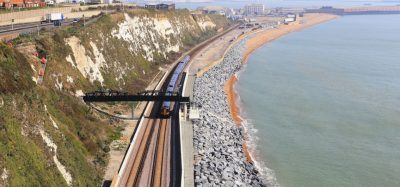Innovations in turnout technology
Posted: 28 November 2006 | | No comments yet
At InnoTrans 2006 in Berlin, Vossloh Cogifer SA, a subsidiary of the Vossloh Group, pre-sented not one, but two innovations in turnout technology primarily for high-speed turnouts. These are, on the one hand, a totally new turnout system for slab tracks, and, on the other, a turnout drive system with fully integrated components.
At InnoTrans 2006 in Berlin, Vossloh Cogifer SA, a subsidiary of the Vossloh Group, pre-sented not one, but two innovations in turnout technology primarily for high-speed turnouts. These are, on the one hand, a totally new turnout system for slab tracks, and, on the other, a turnout drive system with fully integrated components.
At InnoTrans 2006 in Berlin, Vossloh Cogifer SA, a subsidiary of the Vossloh Group, pre-sented not one, but two innovations in turnout technology primarily for high-speed turnouts. These are, on the one hand, a totally new turnout system for slab tracks, and, on the other, a turnout drive system with fully integrated components.
The new turnout system was developed as a genuine, extremely practical joint product: Vossloh Switch Systems (Vossloh Cogifer) developed the entire switch design and coordi-nated the requisite deliveries. Sateba, one of the leading European manufacturers of concrete sleepers, was responsible for these. At the beginning of the project SNCF, the French railway system, defined the product specifications document and the basic concept, and conducted elasticity calculations and simulations in its own laboratories. By contrast, Vossloh Switch Systems, together with its sister company Vossloh Infrastructure Services, was responsible for the fittings.
Considerable improvements to vibration cushioning
Our project partner Sateba supplied the pre-stressed concrete bearer for the new system; this bears the proven track fastening and turnout components. The turnout bearer ‘is suspended’, as it were, on a high-performance polyurethane foam pad. This structure gives the system dynamic qualities very similar to those of track laid on ballast. The presence of the bearer enables considerably improved vibration cushioning in the low frequency range. The new system has clear advantages in comparison with existing systems featuring direct fasteners on fixed slabs, creating as it does a spring load mass system. In order to prevent the intrusion of water and dirt, in the lower areas the bearer is set in a modular ABS plastic shell. The inter-face between the bearer and the ABS shell is fastened in such a way that while the lateral mo-tion of the entire system is restricted, vertical ‘operations’ are still possible. On the ground it is fastened by means of a high-performance pad with static stiffness of 30 to 40 kN/mm. The four sides, on the other hand, feature flexible rubber pads.
This construction method enables damaged bearers to be replaced without breaking up the concrete. This is yet another major advantage of the system, as tolerances during manufac-ture of the bearer are extremely tight. The exchange/installation occurs top down following complete assembly, levelling and alignment. Furthermore, the system does not require special servicing, which in terms of life-cycle costs balances out the added costs resulting from elabo-rate construction.
Since preparing the concrete base requires a considerable amount of time and, as such, is costly, this new method of construction is envisaged for new tracks only.
320kph: maximum speed
The first turnouts have already been installed near Paris on the Eastbound line of the French high-speed rail network TGV. They were designed for a permitted speed of 320 kilometers per hour on continuous stretches of track and up to 170 kilometers per hour for branch lines. In the configuration for standard train traffic the maximum axis load is 250 kN. In terms of fundamental concept, the turnout system is based on the proven S312 Slab Track System, which was installed, for example, on the TGV high-speed line Lyon-Marseille.
EASYSWITCH-R integrates all components
For use, in particular, on high-speed lines with conventional ballast, Vossloh Switch Systems has developed a further innovation know as The EASYSWITCH-R switch system. The ‘R’ in the product name stands for ‘railway’. It was developed for driving switches and crossing swing noses in several types of railway transport and can be used on high-speed lines, lines with heavy traffic, and underground systems.
The system’s special feature, and as such its inherent advantage, lies in the integration of all the switch drive mechanism components in a hollow bearer. This enables maintenance-related down times to be reduced to a minimum, as tamping operations on the line can be conducted automatically and without interruption, including on turnout stretches without trains reducing speed. Signal components such as cables, tubes and rod drives between the bearers are done away with completely.
Vossloh Switch Systems placed great importance in the development process on the safety and reliability of the installed components. To this end, a switch rail locking system as a VCC safety lock with integrated locking and position detectors, a crossing swinging nose as a VPM lock with integrated locking and position detectors, as well as a Paulvé position detec-tor for switch rails and crossing noses are used. In addition, EASYSWITCH-R uses the same hydraulic power unit as is installed in most conventional switch drive mechanisms.
Each system has its own hydraulic power unit
In addition to all the requisite components, EASYSWITCH-R features further innovations. Each system boasts its own hydraulic power unit which avoids hydraulic inter-connections between the various slabs in the same forks. As such, possible sources of errors stemming from the ballast for the connections laid can be ruled out. All the components are modular in design and accessible top down, making service times as short as possible. For this reason, all modules can be replaced within a mere 15 minutes.
Yet another advantage is the compact form. EASYSWITCH-R has the same dimen-sions in terms of height, width and length as the surrounding turnout bearers. With regard especially to high-speed stretches, this criterion is of particular importance. When a train crosses an EASYSWITCH-R unit this responds in exactly the same way as all other turnout bearers, thereby avoiding undesired dynamic effects. For the same reason EASYSWITCH-R allows for mechanical tamping. Initial tests by SNCF have revealed that, as a result of the construction, life-cycle costs are considerably lower than in the case of traditional switch drive systems, which can be attributed first and foremost to the possibility of uninterrupted tamping – a factor on which, as opposed to the past, ever greater importance is now being placed across Europe. For this reason EASYSWITCH-R is not only used on new stretches, but also for retrofits.
All safety components in EASYSWITCH-R have been certified and approved and have been in use as individual component parts on the majority of the world’s major railway networks for decades now. The entire system can be approved and utilized worldwide.
OUT NOW: The Definitive Guide to Rail’s Digital Future
The rail industry is undergoing a digital revolution, and you need to be ready. We have released our latest market report, “Track Insight: Digitalisation.”
This is not just another report; it’s your comprehensive guide to understanding and leveraging the profound technological shifts reshaping our industry. We move beyond the buzzwords to show you the tangible realities of AI, IoT, and advanced data analytics in rail.
Discover how to:
- Optimise operations and maintenance with real-time insights.
- Enhance passenger services through seamless, high-speed connectivity.
- Leverage technologies like LEO satellites to improve safety and efficiency.
Featuring expert analysis from leaders at Nomad Digital, Lucchini RS, Bentley Systems and more, this is a must-read for any rail professional.







